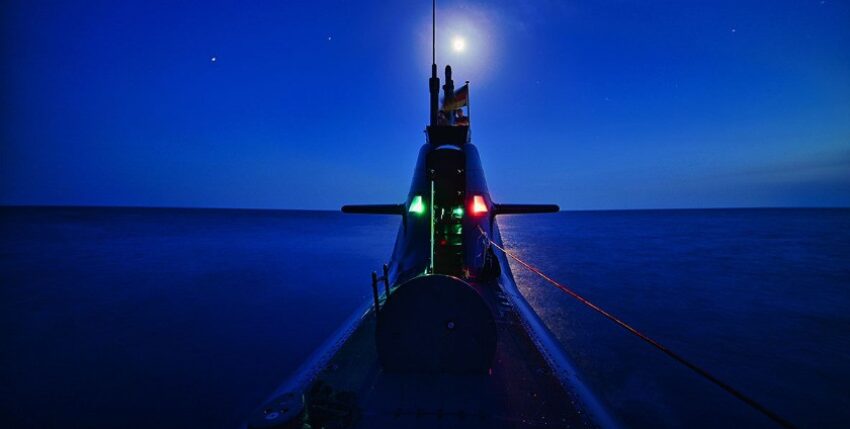In recent years, the German submarines have actively contributed to improving submarine hunting procedures. The knowledge gained will also benefit the future frigates 126.
Last year, the 1st submarine squadron with two submarines simultaneously on two different missions. For just over 70 days, a fleet service boat and the Submarine MAIN support unit with a command staff also deployed. In both very different missions, our weapon systems were able to fully convince as individual operators, but above all in combination. The first simultaneous integration of a support unit in 2020 and 2021 Submarines and a fleet service boat into a sensor reconnaissance network have exponentially increased the effectiveness of the integrated weapon systems. At the same time, decisive potential for effectiveness in anti-submarine warfare (ASW) has been demonstrated, tested and proven.
The German Submarines have impressively demonstrated their strategic value in recent years. Their strategic value for alliance and national defence and thus for Germany's security provision is recognised by the Federal Government. They are therefore of the highest relevance for security policy.
The harvest that the 1st Submarine Wing has reaped with the results of the German Sensor Reconnaissance Organisation (DEU SAV) in the last two years was possible primarily because all commanders have consistently invested their always scarce resources in further development for over ten years. Equally important was the support provided by the Cyber and Information Space Command (CIR), the German Air Force with the Tactical Air Wing 51 Immelmann, WTD 71 and various departments of the Navy.
If we look at the operating time of the Submarines of the Class 212A, we can now say that the first few years of its commissioning from 2005 onwards were primarily characterised by the accumulation of experience. The broad operational deployment of the boats, utilising all the capabilities of the weapon system, only began effectively with the West Atlantic deployment in 2013, with the protagonists at the time standing on the shoulders of their predecessors. To be honest, it must be noted that the Submariner did not want this deployment, as it blocked considerable deployment periods with two 40-day transits. However, when it became clear that the Navy would adhere to this military policy measure, it was the commander at the time, frigate captain Sascha Rackwitz, who decided to invest all of the squadron's available resources in this deployment and in the further development of underwater detection and communication procedures and their evaluation - with success. Even here, the insights gained exceeded all expectations. Since then, subsequent commanders have taken every opportunity to combine not only operational deployments, but also cruises in the area of regeneration and torpedo firing sections with further development. Rackwitz's successor, Jens Grimm, embarked as Commander Task Group (CTG) on an Italian submarine hunting platform and from there led the Smart Hunt manoeuvre, which was conceived in the 1st submarine squadron and served to further develop bi- and multistatic procedures.
With frigate captain Lars Johst, the next squadron commander also continued the series with a consistent approach to the forces in the evaluation of his squadron in the Eastlant series and the Dynamic Mongoose manoeuvres. In addition to German Submarines German sonar and operations officers also took part on participating surface platforms and tested new buoys, procedures and towed sonars. All exercises were followed by an extensive evaluation in Eckernförde. Under the aegis of frigate captain Timo Cordes as commander, another new approach was finally adopted: the combination of new technologies and tried and tested procedures with Submarines and the forces of sea-based reconnaissance in a sensor reconnaissance network - with resounding success.
Today we can say that the most modern underwater detection methods and technologies currently available in the German armed forces, as well as the knowledge about them, are at home in the 1st submarine squadron in Eckernförde.
What comes next? Our goal over the next few years must be to roll out and consolidate this knowledge structurally throughout the entire navy. This not only includes the operational squadrons in Nordholz and Wilhelmshaven, it is also about anchoring the understanding and knowledge of state-of-the-art underwater detection methods and the possibilities of their application in the schools of our navy. It seems particularly important to break out of traditional ways of thinking.
The impression often persists that the German Navy will only be capable of modern submarine hunting once the future frigate 126 with its towed sonar has been accepted. However, the possibilities are already much greater than many people realise. With the buoys currently available and their wide range of applications, the navy can turn almost any unit into a platform that can make a contribution to ASW. Of course, this has to be a force-generation approach and our goal must be to introduce the frigate 126 with its towed sonar, the Sea Tiger in the ASW role and the P-8A Poseidon maritime patrol aircraft as quickly as possible. They will only complete the network. However, the navy is already capable of effective submarine hunting and making important contributions to the NATO alliance. This was impressively demonstrated by non-cooperative Submarines in the Baltic Sea. The chapter is already opening today, in which the broadest possible, consistent application of the material already available and the knowledge generated in the process will lay important foundations that will later benefit the Class 126 frigates.
Frigate Captain Frédéric Strauch is Commander 1st Submarine Squadron.
Frédéric Strauch










